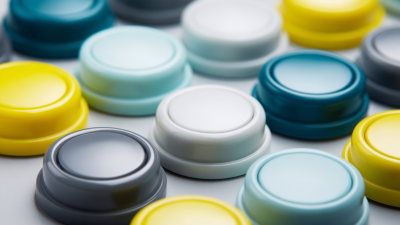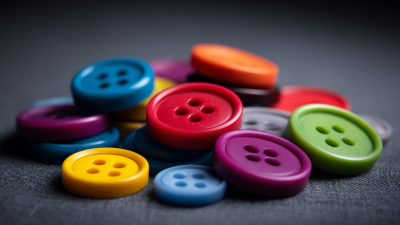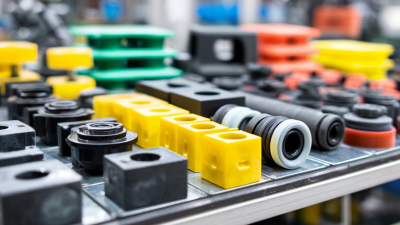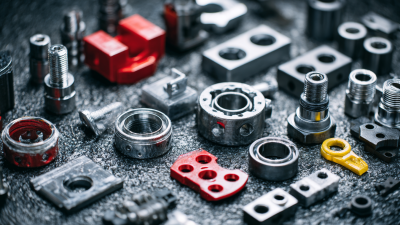Get a custom solution for free
-
Phone
-
E-mail
-
Whatsapp
-
Wechat


The increasing demand for durable and versatile components in various industries has positioned Silicone Rubber Buttons as a crucial element in product design and functionality. According to a recent market analysis by Smithers Pira, the global silicone rubber market is projected to reach $10 billion by 2025, driven by its application in consumer electronics, automotive, and medical devices.

Silicone Rubber Buttons are particularly favored for their excellent thermal stability, chemical resistance, and tactile feedback, making them integral to the usability of devices ranging from kitchen appliances to sophisticated gaming controllers. As product developers seek to enhance user experience while maintaining aesthetic appeal, understanding how to select the best Silicone Rubber Buttons becomes essential. This ultimate guide will navigate through the critical factors to consider, ensuring that your projects incorporate the most suitable components for optimal performance and longevity.
When selecting silicone rubber buttons for various projects, understanding the different types available is crucial for achieving the desired functionality and design. Silicone rubber buttons come in various shapes, sizes, and hardness levels, typically measured on the Shore A scale. For instance, softer buttons (around 30-40 Shore A) provide a tactile, cushioned feel, making them ideal for consumer electronics, while firmer buttons (around 60-70 Shore A) might be better suited for applications requiring durability and resilience.
Recent developments in wearable technology have seen a significant demand for compact input devices. According to industry reports, the global market for silicone rubber keypads is projected to reach over $3 billion by 2026, driven by advancements in miniaturization and user interface design. As projects like customized keyboards for portable gaming and wearable electronics gain traction, engineers are increasingly leveraging silicone rubber due to its versatility and resistance to environmental factors. Whether it's for conference badges or gaming peripherals, choosing the right type of silicone rubber button is critical for ensuring optimal performance in small, integrated designs.
When selecting silicone rubber buttons for your projects, several key factors come into play. First, consider the intended application of the buttons. Different projects may require varying levels of flexibility, durability, and tactile feedback. For instance, if your buttons will be used in high-wear environments, opt for a silicone that offers increased resilience to stress and environmental factors.
Another vital aspect is the design and shape of the buttons. Ergonomics plays a significant role in user experience, so ensure the buttons are not only visually appealing but also comfortable to use. Customization options can also enhance functionality; consider whether you need buttons to be backlit or to feature unique textures for better grip.
**Tips:** When choosing silicone rubber buttons, always request samples to test their feel and performance. Additionally, keep an eye on the manufacturing process, as this can affect the quality and consistency of the final product. Finally, evaluate the cost-effectiveness of different suppliers to balance quality with your project budget, ensuring that you get the best value without sacrificing performance.
This chart illustrates the importance rating of key factors to consider when selecting silicone rubber buttons for various projects. The ratings are based on a scale from 1 to 10, where a higher score indicates greater importance.
When evaluating the durability and performance of silicone rubber buttons for your projects, it is essential to consider several key factors. According to a recent report by the Silicone Rubber Manufacturer's Association, silicone rubber can withstand extreme temperature variations, ranging from -40°C to 200°C, making it suitable for various environments. This thermal stability ensures that buttons maintain their functionality without becoming brittle or losing shape over time, which is critical for applications in electronics and automotive industries.
Additionally, the abrasion resistance of silicone rubber is vital for long-lasting performance. A study published in the Journal of Materials Science reveals that silicone rubber exhibits excellent wear properties, enduring more than 3 million cycles in stress testing. Such resilience helps prevent degradation from repetitive use, ensuring that the buttons retain their tactile feedback and aesthetics. Furthermore, evaluating silicone compositions, like those reinforced with silica, can enhance mechanical strength, contributing to an extended lifespan. By focusing on these performance metrics, you can select silicone rubber buttons that meet the rigorous demands of your projects.

When selecting silicone rubber buttons for your projects, customization options are paramount. The versatility of silicone allows for various shapes, sizes, and colors, enabling designers to tailor products to specific functional and aesthetic requirements. According to a report by Markets and Markets, the global silicone rubber market is projected to reach $21.6 billion by 2026, driven largely by advancements in customization technology that cater to diverse industry needs.
One of the most significant customization options is the incorporation of textures and patterns. This enhances not only the tactile experience but also the visual appeal of the buttons. Custom silicone rubber buttons can feature embossed logos or varying surface finishes, aligning with brand identity while improving grip and usability. Furthermore, color matching is increasingly precise, enabling projects to maintain consistent branding and style. The flexibility in custom formulations also allows for resistance to extreme temperatures and chemicals, catering to specialized requirements in sectors such as automotive and healthcare, which are projected to witness a compound annual growth rate (CAGR) of 5.5% in the silicone rubber segment by 2025. These choices ensure that products are not only functional but also stand out in a competitive marketplace.

When working with silicone rubber buttons, proper maintenance and installation are crucial for ensuring their longevity and functionality. First and foremost, it’s essential to keep the buttons clean. Use a soft, damp cloth to wipe them down regularly, avoiding harsh chemicals that could degrade the material. Additionally, be cautious of extreme temperatures as silicone can become less effective when exposed to excessive heat or cold.
**Tips:** Always store your silicone buttons in a cool, dry place away from direct sunlight. This will help prevent premature wear and discoloration. When installing the buttons, ensure the surface is clean and free of debris to achieve the best adhesion and performance.
Proper installation techniques can also greatly impact the durability of silicone buttons. For instance, applying a uniform pressure during installation helps ensure a secure fit. Be mindful not to stretch or distort the silicone when affixing it, as this can lead to malfunction over time.
**Tips:** Use the manufacturer’s adhesive recommendations for optimal results. If working with electronic devices, double-check compatibility to avoid any operational issues after installation.
| Specification | Description | Best Practices | Maintenance Tips |
|---|---|---|---|
| Material Type | Silicone Rubber is flexible, durable, and resistant to extreme temperatures. | Choose high-grade silicone for better performance in harsh conditions. | Regularly check for wear and replace if damaged to ensure functionality. |
| Durometer Hardness | Commonly ranges from 30A to 90A, indicating softness to hardness. | Select appropriate durometer based on application requirements. | Avoid exposing to chemicals that can degrade material hardness. |
| Temperature Resistance | Typically withstands temperatures from -60°C to 200°C. | Use silicone suitable for the temperature range of the intended application. | Store away from direct heat sources to extend life. |
| Color Options | Available in various colors for visibility and aesthetic purposes. | Consider color coding buttons for different functions to enhance usability. | Clean with mild soap as dirt can affect appearance and tactile feedback. |
| Installation Methods | Adhesive bonding, mechanical fastening, or snap-fit. | Ensure surface is clean and dry before installation for better adhesion. | Inspect installation periodically and adjust if necessary to prevent detachment. |






